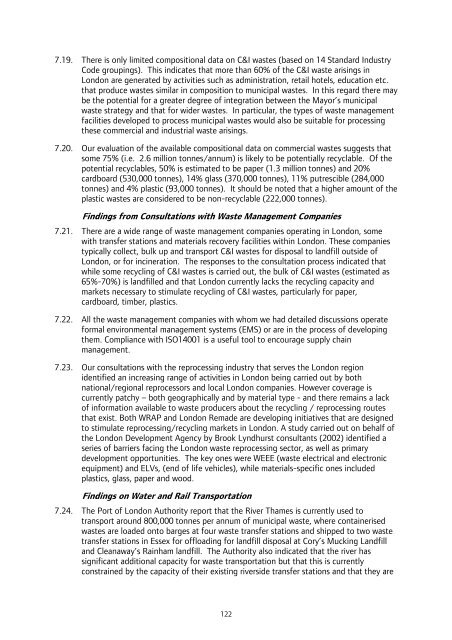London Wider Waste Strategy - London - Greater London Authority
London Wider Waste Strategy - London - Greater London Authority
London Wider Waste Strategy - London - Greater London Authority
You also want an ePaper? Increase the reach of your titles
YUMPU automatically turns print PDFs into web optimized ePapers that Google loves.
7.19. There is only limited compositional data on C&I wastes (based on 14 Standard Industry<br />
Code groupings). This indicates that more than 60% of the C&I waste arisings in<br />
<strong>London</strong> are generated by activities such as administration, retail hotels, education etc.<br />
that produce wastes similar in composition to municipal wastes. In this regard there may<br />
be the potential for a greater degree of integration between the Mayor’s municipal<br />
waste strategy and that for wider wastes. In particular, the types of waste management<br />
facilities developed to process municipal wastes would also be suitable for processing<br />
these commercial and industrial waste arisings.<br />
7.20. Our evaluation of the available compositional data on commercial wastes suggests that<br />
some 75% (i.e. 2.6 million tonnes/annum) is likely to be potentially recyclable. Of the<br />
potential recyclables, 50% is estimated to be paper (1.3 million tonnes) and 20%<br />
cardboard (530,000 tonnes), 14% glass (370,000 tonnes), 11% putrescible (284,000<br />
tonnes) and 4% plastic (93,000 tonnes). It should be noted that a higher amount of the<br />
plastic wastes are considered to be non-recyclable (222,000 tonnes).<br />
Findings from Consultations with <strong>Waste</strong> Management Companies<br />
7.21. There are a wide range of waste management companies operating in <strong>London</strong>, some<br />
with transfer stations and materials recovery facilities within <strong>London</strong>. These companies<br />
typically collect, bulk up and transport C&I wastes for disposal to landfill outside of<br />
<strong>London</strong>, or for incineration. The responses to the consultation process indicated that<br />
while some recycling of C&I wastes is carried out, the bulk of C&I wastes (estimated as<br />
65%-70%) is landfilled and that <strong>London</strong> currently lacks the recycling capacity and<br />
markets necessary to stimulate recycling of C&I wastes, particularly for paper,<br />
cardboard, timber, plastics.<br />
7.22. All the waste management companies with whom we had detailed discussions operate<br />
formal environmental management systems (EMS) or are in the process of developing<br />
them. Compliance with ISO14001 is a useful tool to encourage supply chain<br />
management.<br />
7.23. Our consultations with the reprocessing industry that serves the <strong>London</strong> region<br />
identified an increasing range of activities in <strong>London</strong> being carried out by both<br />
national/regional reprocessors and local <strong>London</strong> companies. However coverage is<br />
currently patchy – both geographically and by material type - and there remains a lack<br />
of information available to waste producers about the recycling / reprocessing routes<br />
that exist. Both WRAP and <strong>London</strong> Remade are developing initiatives that are designed<br />
to stimulate reprocessing/recycling markets in <strong>London</strong>. A study carried out on behalf of<br />
the <strong>London</strong> Development Agency by Brook Lyndhurst consultants (2002) identified a<br />
series of barriers facing the <strong>London</strong> waste reprocessing sector, as well as primary<br />
development opportunities. The key ones were WEEE (waste electrical and electronic<br />
equipment) and ELVs, (end of life vehicles), while materials-specific ones included<br />
plastics, glass, paper and wood.<br />
Findings on Water and Rail Transportation<br />
7.24. The Port of <strong>London</strong> <strong>Authority</strong> report that the River Thames is currently used to<br />
transport around 800,000 tonnes per annum of municipal waste, where containerised<br />
wastes are loaded onto barges at four waste transfer stations and shipped to two waste<br />
transfer stations in Essex for offloading for landfill disposal at Cory’s Mucking Landfill<br />
and Cleanaway’s Rainham landfill. The <strong>Authority</strong> also indicated that the river has<br />
significant additional capacity for waste transportation but that this is currently<br />
constrained by the capacity of their existing riverside transfer stations and that they are<br />
122
















